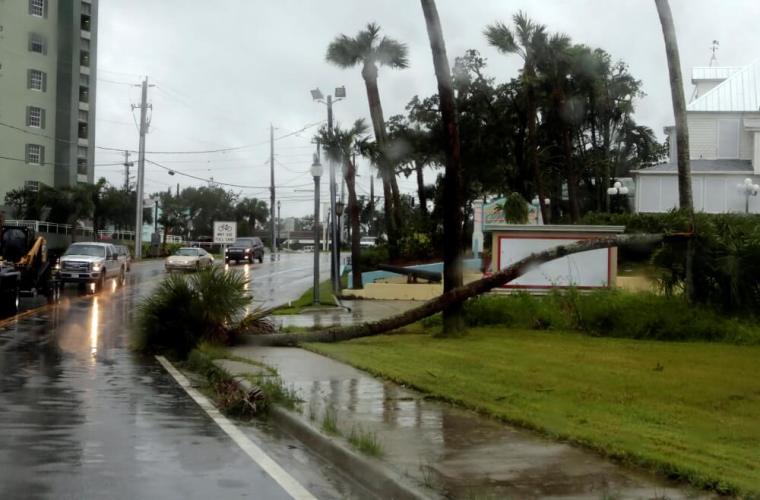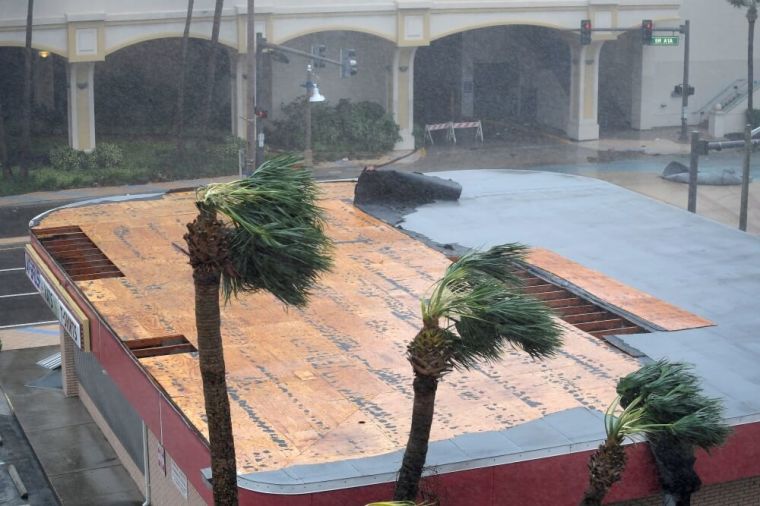Hurricane Matthew Tracker: Storm Strikes Florida Coast, 1 Million Lose Power; Over 800 Dead in Haiti
CHANTAL, Haiti/COCOA BEACH, Fla. — Hurricane Matthew killed more than 800 people and left tens of thousands homeless in its rampage through Haiti earlier this week before it lashed Florida on Friday with howling winds and rumbled northward up the U.S. Atlantic coast.
The number of deaths in Haiti, the poorest country in the Americas, surged to at least 842 on Friday as information trickled in from remote areas previously cut off by the storm, according to a Reuters tally of death tolls given by officials.
Matthew, the fiercest cyclone to affect the United States since Superstorm Sandy hit the Northeast four years ago, triggered mass evacuations along the coast from Florida through Georgia and into South Carolina and North Carolina.
U.S. President Barack Obama urged people not to be complacent and to heed safety instructions in the face of a storm that could be the most severe to strike northeast Florida in more than 100 years.
"I just want to emphasize to everybody that this is still a really dangerous hurricane, that the potential for storm surge, loss of life and severe property damage exists," Obama told reporters after a briefing with emergency management officials.
Matthew smashed through Haiti's western peninsula on Tuesday with 145 mph (233 kph) winds and torrential rain. Some 61,500 people were in shelters, officials said, after the storm pushed the sea into fragile coastal villages, some of which were only now being contacted.
At least three towns in the hills and coast of Haiti's fertile western tip reported dozens of people killed, including the farming village of Chantal where the mayor said 86 people died, mostly when trees crushed houses. He said 20 others were missing.
"A tree fell on the house and flattened it, the entire house fell on us. I couldn't get out," said driver Jean-Pierre Jean-Donald, 27, who had been married for only a year.
"People came to lift the rubble, and then we saw my wife who had died in the same spot," Jean-Donald said, his young daughter by his side, crying "Mommy."
With cellphone networks down and roads flooded, aid has been slow to reach hard-hit areas in Haiti. Food was scarce, and at least seven people died of cholera, likely because of flood water mixing with sewage.
The Mesa Verde, a U.S. Navy amphibious transport dock ship, was heading for Haiti to support relief efforts. The ship has heavy-lift helicopters, bulldozers, fresh water delivery vehicles and two surgical operating rooms.
ONE DEAD IN FLORIDA
Matthew skirted Florida on Friday morning with winds of up to 120 miles per hour (195 kph), but had not made landfall by afternoon. The U.S. National Hurricane Center later downgraded the storm to a Category 2 on the five-step Saffir-Simpson scale of hurricane intensity as its sustained winds dropped to 110 mph. A Category 5 is the strongest.
No significant damage was reported in cities and towns in south Florida where the storm brought down trees and power lines. But one person was killed by a falling tree in Volusia County after venturing outside to feed animals during a lull in the storm, said James Dinneen, manager of the county that includes Daytona Beach.
Hurricane warnings extended up the Atlantic coast from central Florida through Georgia and South Carolina and into North Carolina.
In Daytona Beach, the street under the city's famed "World's Most Famous Beach" sign was clogged with debris washed up by the ocean. The waves had receded by early afternoon but there was damage throughout the city, including a facade ripped off the front of a seaside hotel.
The city of Jacksonville could face significant flooding, Governor Rick Scott said. The storm cut power to some 1 million customers in Florida, his office said.
Armed guards patrolled the outside of Fox Hill prison in Nassau, the only prison facility in the Bahamas, after the storm knocked down parts of its concrete walls.
No deaths were reported from the Bahamas, but residents of Nassau were still without power on Friday.
At 5 p.m. (2000 GMT), Matthew's eye, or centre, was brushing the northeast Florida coast near Jacksonville, the NHC said.
It was on a path that would likely take it near or over the coast of northeast Florida and Georgia through Friday night and near or over the coast of South Carolina on Saturday.
Craig Fugate, director of the Federal Emergency Management Agency, said he was concerned that relatively light damage so far could give people farther up the coast a false sense of security.
"People should not be looking at the damages they're seeing and saying this storm is not that bad," Fugate told NBC.
"The real danger still is storm surge, particularly in northern Florida and southern Georgia. These are very vulnerable areas. They've never seen this kind of damage potential since the late 1800s," Fugate said.
In Cape Canaveral, Florida, home to the country's main space launch site, the storm downed power lines and trees and destroyed billboards.
The U.S. National Weather Service has said it could be the most powerful storm to strike northeast Florida in 118 years.
RELUCTANT TO LEAVE
In St. Augustine just south of Jacksonville, about half of the 14,000 residents refused to heed evacuation orders despite warnings of an eight-foot (2.4- meter) storm surge that could sink entire neighbourhoods, Mayor Nancy Shaver said in a telephone interview from the area's emergency operations centre.
Even as power started to dim and water was shut off in St. Augustine, the oldest U.S. city and a major tourism attraction, residents, especially elderly and the working poor, refused to budge, she said.
"There's that whole inability to suspend disbelief that I think really affects people in a time like this," Shaver said.
In addition to those who simply did not believe the storm was a major threat, some of the city's residents lacked vehicles or other means to evacuate, said Shaver.
Lack of means to move was one reason some people stayed in New Orleans before it was hit by Hurricane Katrina in 2005. The storm killed more than 1,800 people there and along the U.S. Gulf Coast.
About 22,000 people were in Florida shelters and Georgia and South Carolina also opened dozens of shelters for evacuees.
(Reporting by Susan Heavey, Eric Walsh and Doina Chiacu in Washington; Gabriel Stargardter in Miami; Zachary Goelman in Orlando, Fla.; Zachary Fagenson in Wellington, Fla.; Irene Klotz in Portland, Maine; Laila Kearney in New York; Colleen Jenkins in Winston-Salem, N.C.; Neil Hartnell in Nassau; Writing by Frances Kerry; Editing by Alistair Bell and Tom Brown)


































